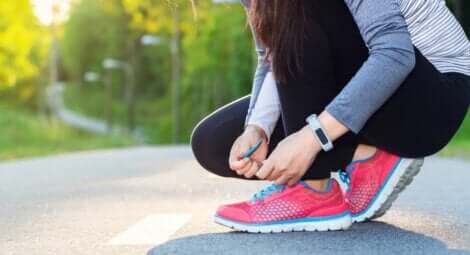The 7 Best Tips to Improve Poor Leg Circulation

As you grow older, you may feel and see the effects of poor leg circulation. For example, heavy legs, varicose veins, and cellulite are all signs of poor leg circulation. Therefore, good leg circulation not only is a question of health, but also of beauty.
In this article, we’ll explore seven of the best tips to fight poor leg circulation.
Tips for improving leg circulation

1. Avoid a sedentary lifestyle
The first step to improving leg circulation, and the most logical, is moving them on a daily basis. Unfortunately, more and more people are living more sedentary lives. People nowadays spend hours on end sitting without getting up or moving around, which is very dangerous for long-term health.
You mustn’t spend most of your time sitting. You can even set an alarm so you don’t forget. It’s enough to simply get up and walk around for a few minutes or do a few stretches. You can use this time productively, as well – for instance, by running some errands, going to the bathroom, drinking water, etc.
Discover: The Best Dynamic Stretches Before Running
2. Improve your posture
On the other hand, people who spend several hours standing need to be aware of their posture. Sitting or standing with poor posture is equally bad. This is very important in those who work in stores.
If you have very poor posture, there’s therapy available to help you relearn how to walk, stand, sit, bend, hold weight, and breathe correctly. This way, the circulation in your legs will also improve.
3. Walk, jump, and use the stairs
Whenever you can, you should choose to move. See escalators, elevators, and reclining chairs as the enemy. You need to give your legs more active time to go up and down the stairs, power walk, jump… You can do this anytime in your day.
Even if you work out or play sports a few times a week, it’s important to stay active throughout the day. Try to think of children who are sitting one moment and then running the next. Try to have that same dynamic attitude.
Discover: The Best Exercise Routine To Do At Home
4. Eat red foods

Food has different nutritional properties that can be identified by their color. For example, red foods contain antioxidants, which is why its said that they help improve circulation and prevent cardiovascular diseases.
Therefore, you should try to eat fresh healthy foods every day. If possible ,you should opt for those rich in lycopene and anthocyanins:
- Berries
- Tomatoes,
- Watermelon
- Cherries
- Red grapes
- Red peppers
- Radishes
- Red apples
5. Drink water every hour
Drinking water can improve many things, so this tip isn’t to be underestimated. If you want your body fluids to flow, your must drink water at all times, but always on an empty stomach, outside of meals.
You should drink at least a liter of water a day to stay hydrated. If you don’t like the taste of water, you can always drink infusions, fruit drinks, or lemon water. However, make sure not to add any sugar. The key is to always have a glass or bottle of water nearby. That way, every time you look at it, you’ll remember to take a sip.
6. Wear the right shoes

In many cases, improper footwear can cause problems with leg circulation. This can be caused by shoes with a heel, shoes that are too narrow or too wide, or shoes that are too big or too small. Footwear supports the foot and is the foundation that holds and supports our body weight. Therefore, it’s important to have adequate footwear to improve circulation.
From time to time, you should also take your shoes off and enjoy walking barefoot on the beach, the sand, or on grass. This provides much-needed relief for our legs and releases electromagnetic pollution.
7. Relax when you get home
Finally, when you get home, you can take a cold shower or just rinse off your legs with cold water. You can also apply some oil or cream with ingredients that improve circulation, such as cypress, rosemary, cinnamon, witch hazel, horse chestnut, etc. All of this helps improve leg circulation.
Did you know? Medicinal Plants that Help Eliminate Cellulite
Before going to bed, you can also elevate your legs for a little while. You can even prop them up perpendicularly on a wall. You can also sleep with your legs slightly elevated on a pillow. There are even specific pillows and cushions just for this purpose that can help relieve our legs and help us wake up with light, relaxed legs.
All cited sources were thoroughly reviewed by our team to ensure their quality, reliability, currency, and validity. The bibliography of this article was considered reliable and of academic or scientific accuracy.
- Klingelhoefer, L., Bhattacharya, K., & Reichmann, H. (2016). Restless legs syndrome. Clinical Medicine, Journal of the Royal College of Physicians of London. https://doi.org/10.7861/clinmedicine.16-4-379
- Allen, R. P., Picchietti, D., Hening, W. A., Trenkwalder, C., Walters, A. S., Montplaisi, J., … Zucconi, M. (2003). Restless legs syndrome: Diagnostic criteria, special considerations, and epidemiology. A report from the restless legs syndrome diagnosis and epidemiology workshop at the National Institutes of Health. Sleep Medicine. https://doi.org/10.1016/S1389-9457(03)00010-8
- Phillips, B., Young, T., Finn, L., Asher, K., Hening, W. A., & Purvis, C. (2000). Epidemiology of restless legs symptoms in adults. Archives of Internal Medicine. https://doi.org/10.1001/archinte.160.14.2137
- Comella, C. L. (2014). Treatment of Restless Legs Syndrome. Neurotherapeutics. https://doi.org/10.1007/s13311-013-0247-9
This text is provided for informational purposes only and does not replace consultation with a professional. If in doubt, consult your specialist.








